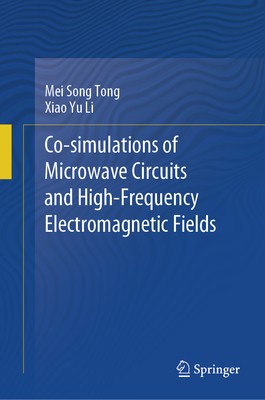
- We will send in 10–14 business days.
- Author: Mei Song Tong
- Publisher: Springer
- ISBN-10: 9819983061
- ISBN-13: 9789819983063
- Format: 15.6 x 23.4 x 2.5 cm, hardcover
- Language: English
- SAVE -10% with code: EXTRA
Co-Simulations of Microwave Circuits and High-Frequency Electromagnetic Fields (e-book) (used book) | bookbook.eu
Reviews
Description
This book provides a number of advanced application topics for microwave circuits and high-frequency electromagnetic fields using advanced design system (ADS) and high-frequency structure simulator (HFSS) as simulation platforms, and contains the latest multidisciplinary co-simulation guide on designing relevant components and devices. As the complexity of products is continuously increased and their performances are constantly improved structural modeling, circuit/field design, and performance analysis and optimization strongly rely on robust electronic design automation (EDA) software. RF/microwave engineers must grasp two or more types of related simulation design software. The ADS software by Keysight is the representative for circuit simulations, and the HFSS by Ansys is the one for field and structural simulations of microwave devices. At present, these two kinds of software are widely used in enterprises, universities, and research institutions. The purpose of this book is to enable readers who are interested in microwave engineering and applied electromagnetics to master advanced engineering applications of the two kinds of software. This book also helps readers expand their knowledge boundaries behind those types of software and provides a deeper understanding of the development of interdisciplinary technologies by co-simulations.
The book is divided into eight chapters within three parts. The first part (Chapter 1) introduces the two latest versions of ADS and HFSS and helps readers increase their understanding of the basic principles and latest functions. It also offers advice on how to choose appropriate simulation tools for different problems. The second part (Chapters 2 to 7) mainly describes co-simulations for high-frequency electromagnetic fields, microwave circuits, antenna designs, electromagnetic compatibility (EMC), and thermal and structural analyses. It provides guides and advices on performing co-simulations by using ADS and HFSS incorporated with other kinds of software, respectively. The last part (Chapter 8) describes the automation interfaces and script programming methods for co-simulations. It primarily introduces the Advanced Extension Language (AEL), the Python Data Link (PDL), and the MATLAB interface in the ADS. For the HFSS, the chapter discusses VBScript, IronPython scripting, and the Application Programming Interface (API) based on the MATLAB. Each topic is accompanied by practical examples to aid understanding. In this part, readers can gain a solid grasp of knowledge and skills regarding automated interfaces and scripting methods based on these kinds of software.
Concisely written in combination with the applications of practical examples, this book is very suitable as a textbook in introductory courses on circuit and electromagnetic simulations and also as a supplementary textbook in many courses for those majoring in electronic science and technology, microwave engineering, communication engineering, and related fields. As well, it can serve as a reference book for senior simulation engineers and professional researchers.
EXTRA 10 % discount with code: EXTRA
The promotion ends in 20d.09:24:47
The discount code is valid when purchasing from 10 €. Discounts do not stack.
- Author: Mei Song Tong
- Publisher: Springer
- ISBN-10: 9819983061
- ISBN-13: 9789819983063
- Format: 15.6 x 23.4 x 2.5 cm, hardcover
- Language: English English
This book provides a number of advanced application topics for microwave circuits and high-frequency electromagnetic fields using advanced design system (ADS) and high-frequency structure simulator (HFSS) as simulation platforms, and contains the latest multidisciplinary co-simulation guide on designing relevant components and devices. As the complexity of products is continuously increased and their performances are constantly improved structural modeling, circuit/field design, and performance analysis and optimization strongly rely on robust electronic design automation (EDA) software. RF/microwave engineers must grasp two or more types of related simulation design software. The ADS software by Keysight is the representative for circuit simulations, and the HFSS by Ansys is the one for field and structural simulations of microwave devices. At present, these two kinds of software are widely used in enterprises, universities, and research institutions. The purpose of this book is to enable readers who are interested in microwave engineering and applied electromagnetics to master advanced engineering applications of the two kinds of software. This book also helps readers expand their knowledge boundaries behind those types of software and provides a deeper understanding of the development of interdisciplinary technologies by co-simulations.
The book is divided into eight chapters within three parts. The first part (Chapter 1) introduces the two latest versions of ADS and HFSS and helps readers increase their understanding of the basic principles and latest functions. It also offers advice on how to choose appropriate simulation tools for different problems. The second part (Chapters 2 to 7) mainly describes co-simulations for high-frequency electromagnetic fields, microwave circuits, antenna designs, electromagnetic compatibility (EMC), and thermal and structural analyses. It provides guides and advices on performing co-simulations by using ADS and HFSS incorporated with other kinds of software, respectively. The last part (Chapter 8) describes the automation interfaces and script programming methods for co-simulations. It primarily introduces the Advanced Extension Language (AEL), the Python Data Link (PDL), and the MATLAB interface in the ADS. For the HFSS, the chapter discusses VBScript, IronPython scripting, and the Application Programming Interface (API) based on the MATLAB. Each topic is accompanied by practical examples to aid understanding. In this part, readers can gain a solid grasp of knowledge and skills regarding automated interfaces and scripting methods based on these kinds of software.
Concisely written in combination with the applications of practical examples, this book is very suitable as a textbook in introductory courses on circuit and electromagnetic simulations and also as a supplementary textbook in many courses for those majoring in electronic science and technology, microwave engineering, communication engineering, and related fields. As well, it can serve as a reference book for senior simulation engineers and professional researchers.


Reviews